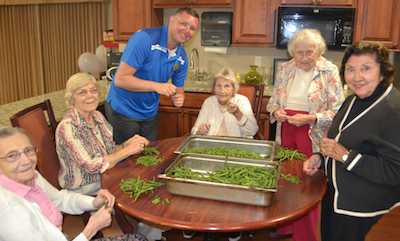
Everybody needs nutrition.
No matter who the resident is, what diagnoses he or she may have or what his or her preferences are, nourishment is necessary.
That is why senior living and healthcare providers from all across the spectrum are finding innovative ways to make the dining experience more exciting, beneficial and meaningful.
Operators around the country, and companies that serve them, are working to change the face of dining in senior living communities. They are sourcing local food, creating programming and making eating a social outlet for residents.
| HarborChase of Palm Beach Gardens launches vertical gardens
HarborChase of Palm Beach Gardens in Florida, a new assisted living and memory care community managed by Harbor Retirement Associates, has installed vertical gardens to produce a farm-to-table dining experience for residents and guests. The gardens are located in lounge areas, kitchen areas, restaurants and in memory care. Their herbs are used to enhance salads, wraps and meals. “It’s easy to impress residents when you have tools like this to work with,” said Chris Blum, director of hospitality at HarborChase of Palm Beach Gardens, mentioning basil he had just picked that morning for chicken parmesan later in the day. Gottfried Ernst, vice president of hospitality at HRA, said the gardens represent the company’s “culture of hospitality.” “We are partnering with a reputable third-party company to service the vertical gardens so that our culinary teams always have freshest lettuce and herbs available at their fingertips,” he added. The gardens already are very popular with the community’s residents and are a draw for potential residents, according to the company. HRA plans to expand the concept into additional communities soon. |
“We impact the lives of seniors everyday,” said Dori Mendel, senior communications manager for Morrison Community Living. “We are not only serving meals, we are serving socialization. We are entrusted partners helping seniors live their their best lives.”
Create programming
Nutrition is necessary to stay alive, but that doesn’t mean it can’t be an event, too. Many senior living communities are implementing programs to bring food into programming events.
Northbridge Companies, a senior living operator with communities in the New England region, for instance, held a “Chopped” style competition for one of its communities earlier this month. Residents had the opportunity to go to a local farm and pick the mystery ingredients. After, residents joined in on the meal the chefs prepared for the competition.
Jennifer Hastings, director of marketing for Northbridge Companies, said the residents love trips out to the local farm and getting to see the food used in the kitchen.
“They feel like they are part of something, and they are so involved in the choice,” she said.
Morrison Community Living, a comprehensive food and environmental services contract provider that serves all levels of housing and care, offers a variety of programs to its clients. Each year, the company offers an annual dining theme. This year, the theme is “heirloom.” The heirloom program features 12 residents and their traditional family recipes throughout the year. Residents have the opportunity to experience a dish that is an important part of a fellow resident’s past.
The company also offers a variety of programs, such as demo kitchens, where residents can watch live food preparation demonstrations and then join in on eating the creations afterward. Mendel cited an event where a community had featured a superfood such as blueberries and residents joined in making blueberry muffins that they ate for breakfast the next day.
Employees at Morning Pointe, an Ooltewah, TN-based senior living operator, agreed that meals are an important way for seniors to socialize.
“Mealtime to this generation is still an event,” said Bruce Fisher, senior food services director at Morning Pointe of Lexington-East in Kentucky. “It’s a social hour.”
Morning Pointe offers a Farm to Table program that uses in-season, local produce for daily meals. The program is made possible through partnerships with local farms.
Greg Vital, president and CEO of Morning Pointe, said Morning Pointe’s partnership with local farms gives residents a unique opportunity for life enrichment. They can take field trips to the farms and when they come back, do things such as snap beans or clean strawberries.
| Dining increasingly valued
Executives at senior living communities and skilled nursing facilities are placing increasing value on the ability of dining to attract prospective residents at the same time that workforce stability challenges their ability to manage food service in-house, according to the results of a survey that LeadingAge and the Unidine Senior Living Culinary Group released at the end of last year. As McKnight’s Senior Living reported at the time, LeadingAge and Unidine, a provider of food and dining management services, said they collaborated on the survey to better understand the evolving nature of foodservice in aging services. Among those surveyed, 86% said they prominently feature dining as part of their marketing and sales strategies. Almost two-thirds (65.2%) of respondents, however, said they faced challenges with workforce stability, 37.1% said they were vexed by cost control issues and 33.3% said they experienced difficulty integrating departments. |
“With this program, we’re going back to our roots,” Vital said. “We want to show importance to our residents’ traditions and values by bringing this wholesome dining experience to the table.”
Keep it sustainable
Given the number of people residing in senior living communities, providers have the opportunity to make a difference environmentally by buying local.
Hastings said one of Northbridge Companies’ communities, Stroudwater Lodge, has a menu with 90% to 95% locally sourced food. The Eat Fresh, Eat Local program has been around since the company was founded in 2004. The company, which operates 16 (soon to be 17) communities, partners with 40 New England farms to bring fresh and local food to senior living dining.
Being a local business, it was important to support other local businesses, Hastings said.
“It is an opportunity for us to build our menu around seasonal ingredients,” she said. “Anyone wants that when they go out to eat a restaurant, so we knew that was something our residents would want.”
Morning Pointe’s Farm to Table program is a similar concept. Vital values it because of his commitment to the agriculture economy and local farms.
“Why shouldn’t we buy local if we can?” he said.
Taking a different spin on sustainable dining, Morrison Community Living offers a program called Imperfectly Delicious. This program partners with farms that have crops that come out looking less than beautiful, but they still have the same nutritional value as normal fruits and vegetables.
The program helps cut back on environmental waste, because the “imperfect” produce otherwise would end up unused. Last year, the program rescued 2 million pounds of produce, said John Rifkin, the senior corporate executive chef at Morrison Community Living. It even reduced food costs by 23%.
“It doesn’t matter if it’s not the perfect pepper,” he said. “We buy it, slice it, dice it and get creative with it.”
Residents and families both enjoy the priority Morrison Community Living puts on the environment, Rifkin added.
| More on memory care
Dementia can present a challenge in the dining services area, because residents with dementia often lose weight as the disease progresses. To encourage eating among residents with dementia, Unidine announced its Fresh Bites nutrition program in late 2015. Food is meant to be eaten without the need for utensils, because many memory care residents lose motor skills and often wander during mealtimes. The offerings don’t include dry fillings, which can fall apart, nor boiled vegetables, which can be too slippery. Ingredients that have shown promise in improving cognitive function have been incorporated into recipes: the spice turmeric, broccoli, cabbage, green tea, blueberries and dark chocolate. |
“Every generation has a sweet spot for giving back to the environment,” he said. “Once you tell people exactly what you’re doing, they feel proud that we go through such lengths to worry about environment, waste and resident health.”
It’s all about the resident
In the end, it really is all about how can the dining experience help residents.
Increasing nutrition is probably the first benefit of dining programs that comes to mind. The locally sourced fruit and vegetables is a great way to ensure residents are getting proper nutrition, Morning Pointe’s Vital said.
Teaching kitchens also can be a great way to show rehab residents proper cooking techniques, Rifkin said. Often, they are there for a reason, such as heart disease, that is linked to food.
It goes far beyond nutrition, however. There are many benefits for residents’ mental health as well. Food can help stimulate memories, which is beneficial for residents who have Alzheimer’s disease or dementia.
“If you cook something and they remember something like, ‘My wife used to cook chicken and dumplings,’ it’s just like that,” Morning Pointe’s Fisher said. “It goes back to the meaningful day where you cooking food that our residents used to eat, and prepare it the way they used to prepare it.”
Vital agrees. He said he believes residents find it reminiscent of the time they spent growing up on a farm or sitting on the front porch with their grandparents, snapping beans.
Northbridge Companies take it one step further. It offers a program called Memory Making Baking. The program allows memory care residents to bake an item. While they are preparing the dish, the same thing already is baking, so they can enjoy the smells of the dish while they are physically preparing it. Then they get to immediately enjoy the baked treat once preparation is done.
The company even is planning to create a “Memory Making Baking” cookbook for residents.
“It was developed to tie together the senses of touch, smell and taste with nostalgia,” Hastings said. “It is simple, but it has been hugely successful.”
Aside from all the health benefits, food is a common thing all residents share, so it is a step toward creating more connected and meaningful experiences for residents.
“We really are of the mindful that food and taste are so important to all of us as individuals,” Hastings said. “That doesn’t change as we age.”




